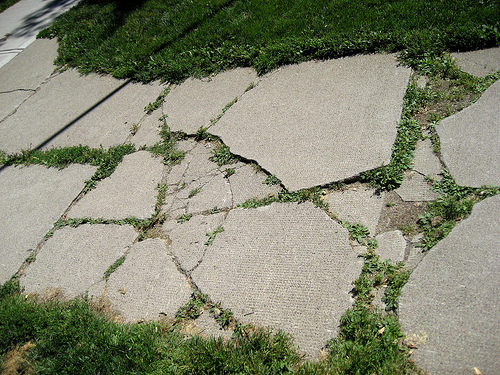Cracked Up

If you go to law school in the United States, you’ll end up taking a class called torts, which discusses the duties we all owe to each other and the liabilities we incur when those duties are breached. If you’re on someone else’s property (let’s assume with permission), for example, and you’re injured because of a defect on their property, there’s a good chance you can sue that person for the damages you suffer. And for better or for worse, it makes a lot of strategic sense to sue everyone involved — especially those with deep pockets.
In the 1970s, the city of New York was up against this particular problem. Financially, the city — the government, that is — wasn’t in the best of shape. In October of 1975, the mayor at the time, Abraham Beame, drafted a statement stating that the city was on the brink of bankruptcy, but a $2.3 billion Federal bailout (that’s nearly $10 billion in today’s dollars) in the form of loans buoyed New York over the next three years. The relative paucity of the city’s budget, though, resulted in the substandard maintenance of basic infrastructure, and specifically to this story, a higher-than-expected number of cracked sidewalks and potholed roads. Those cracked surfaces led to trips, falls, and injuries, and ultimately to lawsuits against the city. So in 1979, the city made it harder to bring a lawsuit for injuries caused by a cracked sidewalk or the like. The city passed a law which prevented an injured party from suing the government unless the government had advance notice that the sidewalk in question was, indeed, cracked.
The maneuver backfired spectacularly.
The ordinance, New York City Administrative Code § 7-201(c)(2), held that “no civil action shall be maintained against the city” for such trip-and-fall injuries unless “written notice of the defective, unsafe, dangerous or obstructed condition, was actually given to the commissioner of transportation [or his or her designee]” at least fifteen days before the accident occurred. Practically speaking, this made it nearly impossible for a victim to bring a lawsuit against the city. Not only was predicting which crack among thousands was the one you needed to report (and do so with more than two weeks worth of foresight), but even if you somehow could do that, navigating the process in order to get your report to the commissioner of transportation was well beyond the means or know-how of laymen.
So experts stepped in. Trial lawyers.
The New York State Trial Lawyers Association is an organization of attorneys who typically represent plaintiffs (the allegedly injured parties) in lawsuits. In 1982, its members got together and created the Big Apple Pothole and Sidewalk Protection Committee, a group which mapped the locations of the city’s pedestrian and automotive infrastructure failings, a massive undertaking requiring thousands of hours of work. According to Wikipedia, the “organization produced an average of 5,000 maps per year, covering all five boroughs and 13,000 miles of sidewalk, and noting more than 700,000 sidewalk hazards.” The Committee then delivered the maps to the commissioner of transportation — over the objection of the city (which required a court order to overturn) — and did so every year through 2005. In doing so, not only did the Committee get around the 1979 ordinance, but also provided evidence for every trip-and-fall plaintiff that the city knew or should have known about the damaged sidewalk that caused them harm. The law, designed to stop lawsuits, had the exact opposite effect.
In 2003 — after suffering hundreds of millions of dollars in lawsuits — the city revised the administrative code again. This time, the city shifted the responsibility for maintaining sidewalks to the person or corporation which owned the land adjacent to the sidewalk, with some small exceptions. (Streets and therefore potholes are still the responsibility of the city.) The Committee soon thereafter stopped making the maps, but some old ones still exist. Unfortunately, they’re relics, and not all that valuable to would-be litigants. Courts now frown on their use, holding that the markings used to signify cracks were too vague.
Bonus Fact: Stroll down Hollywood Boulevard in Los Angeles and you’ll hit the Hollywood Walk of Fame, featuring more than 2,000 star-shaped plaques honoring entertainers of all stripes. Almost all of the Walk of Fame stars are on the sidewalk itself, but there is one notable exception. Muhammed Ali’s star is on a wall of the Kodak Theater. He requested that it not be on the sidewalk because, in the words of one website covering the exhibit, he “did not want to be walked on.”
From the Archives: The Chief’s Fleet: Another New York story.
Related: “Where the Sidewalk Ends” by Shel Silverstein. A classic.
Image via Chris Campbell on Flickr, used under a Creative Commons license.
